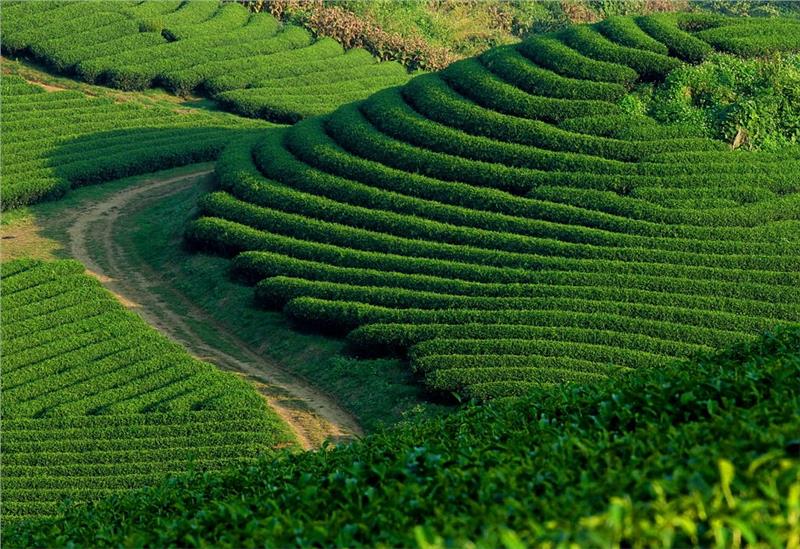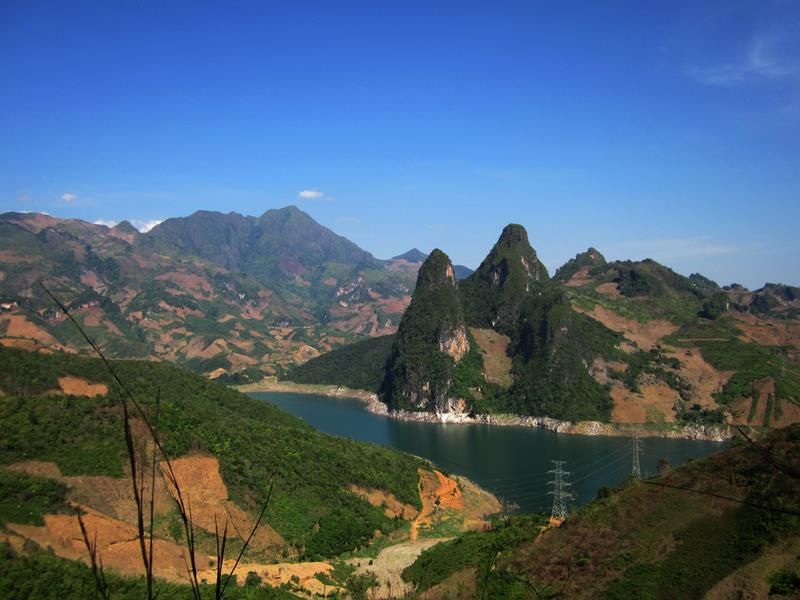"Son" means mountain. "La" means stream. "Son La" means a land derived from a stream in a mountain. Undergoing many changes in history, Son La still looks like a gentle stream sheltering residents of 12 Vietnamese ethnic minority groups. On September 3rd, 2008, Vietnam Government issued Decree No. 98/2008/NĐ-CP on the establishment of Son La City. Over many years of constructions and development, under the leadership of provincial leaders, citizens and authorities in Son La have promoted the tradition of solidarity and creativity, evoked potentials and strengths, and taken advantage of investment resources to make the province become the leading center in all fields of economy, politics, culture, and society. As a convergence of 12 ethnic minority groups, Son La is a land of multi-colored culture having 47 cultural historical relics and scenic beauty. This is a land of fine dishes, captivating dances, sweet folk songs, and special festivals.

Son La is a mountainous province in Northwest Vietnam. The province is located from 20039’ to 22002' North latitude and from 103011' to 105002' East longtitude. It shares borders with Yen Bai Province and Lao Cai Province in the north, Hoa Binh Province and Phu Tho Province in the east, Lai Chau Province and Dien Bien Province in the west, and Thanh Hoa Province in the south. Besides, Son La also shares 250km border with Laos. It is 320 kilometers from the northwest of Hanoi capital. The natural area of the region is about 14,055 square kilometers, accounting for 4.27% of the entire national area.
Son La terrace is divided into small sub-regions with different ecological characteristics. The province has two plateaus, which are Moc Chau and Na San. Moc Chau Plateau has the average height of 1,050 meters above the sea level. It is characterized by sub-temperate climate with fertile soil, which is quite favorable to develop tea tree, fruit trees and dairy farming. Na San Plateau has the average elevation of 800 meters running along Highway 6. The soil in Na San Plateau is also quite fertile; therefore, this is a good land to grow sugarcane, coffee, mulberry, mango, longan, pineapple, and so on.
Refering to Son La climate, the province is under the influence of the tropical monsoon climate with cold and dry winters and hot and humid summers. Son La topography is strongly fragmented creating many sub-climate zones. Son La has two distinct seasons including dry season and rainy season. The average temperature is approximately 21.40C. The annual average rainfall is from 1,200 - 1,600 mm. The average annual humidity is 81%.
Mentioning to Son La history, Son La City is formerly known as Son La Town established on October 26th, 1961 by Decision No. 173/QĐ-CP of the Government Council. The administrative boundary when the town was newly established consisting of Chieng Le Street and Chieng Coi Town. On August 26th, 1945, under the leadership of Vietnam Party, citizens of Son La Town along with citizens in Son La Province in particular and in the whole country in general bravely fought against French colonialism and Japanese fascists to protect the country. In the war against American imperialism, Son La Town won many glorious victories and contributed a lot to the victory in Spring 1975 to liberate the South and make national reunification. On September 3rd, 2008, Vietnam Government issued Decree No. 98 / ND-CP on the establishment of Son La City.
In the history of thousand years of development, Son La has undergone many changes in the administrative boundary. Nonetheless, in any circumstances, this land still keeps strategic position in politics, economy, society, social security and defense and in diplomatic relations with Laos. Nowadays, Son La Province has one city (Son La City) and 11 districts, including Quynh Nhai, Muong La, Thuan Chau, Phu Yen, Bac Yen, Mai Son, Song Ma, Yen Chau, Sop Cop, and Van Ho. Son La City currently has 7 districts (including To Hieu, Chieng Le, Quyet Thang, Quyet Tam, Chieng An, Chieng Sinh Chieng Coi) and 5 communes (which are Chieng Co, Chieng Den, Chieng Xom, Chieng Ngan, and Hua La).
According to the statistics in 2012, Son La population was 1,134,300 people. The population density is about 80 persons/ km2. Son La is home of 12 ethnic groups involving Thai, Kinh, H'mong, Muong, Dao, Kho Mu, Xinh Mun, Khang, La Ha, Lao, Tay, and Hoa. In which, Thai is the largest community in Son La accounting for 54% of the population. The percentage of Kinh, H'mong, Muong, and Dao is respectively 18%, 12%, 8.4%, and 2.5%. The rest is figure of Kho Mu, Xinh Mun, Khang, La Ha, Lao, Tay, and Hoa.

Son La is a special land of not only majestic mountains but also distinct cultural values representing for the typical culture of ethnic minority groups in the Northwest Vietnam. Being known as a convergence of 12 ethnic groups, Son La culture is the blend of different culture.
At present, the province has still preserved over 100 cultural historical relics and archaeological relics, in which, 9 of them were recognized in the national level. Except from the remnants from the early Le Dynasty to the period against French colonialism, archaeologists also found traces of the ancient Vietnamese and collected productivity tools of prehistoric man. Especially, in Son La Museum, unique culture of 12 ethnic groups living in Son La was preserved through hundreds of artifacts in prehistoric times.
If Ban and peach flower is symbol of Son La, their dances are like hundreds of beautiful flowers in a garden. These dances bring their distinct cultural identity and presents for their pure souls. The captivating dance is one of the most special features making people unforgettable experiences when visiting the city.
With 54% Thai ethnic people, Thai language is the most common language in Son La Province. Thai language belongs to Thai - Tay language. The second popular language in the province is Kinh language (official Vietnamese language) because Kinh group is the second largest community in Son La. In addition to Thai and Kinh language, Mon-Khome and Viet - Muong are widely used by other ethnic groups.

Lying on the upstream of two big rivers - Black River and Da River, Son La has great potentials to develop raw materials with a scale of over 20,000 hectares. This materials will be used for wood processing, paper, and paper pulp production. Besides, the province has favorable conditions to grow industrial crops, fruit trees, and other high economic trees such as mulberry, silk, coffee, tea, fresh vegetables, flowers, and ornamental plants. Each year, Son La harvests 18,000 - 20,000 tons of corn and soybeans - the main sources for the industrial processing of animal feeds. In addition, Son La is also a great land for poultry and animal husbandry on the industrial scale.
Since its inception (on October 26th, 2008), Son La economy has been stabilized with the reasonable growth rate. The city's economic structure continues maintaining under the direction of the urban economy. Services - Industry - Construction - Agriculture - Forestry - Fishery of the city gradually meet the criteria of grade III. Trade and services are developing not only in size but also in type with the attendance of diverse economic sectors. Industry and construction are positively invested under the direction of renewing equipment and technology and enhancing the capacity and efficiency of business.
Programs and activities on culture, education, health, and sport in Son La Province are maintained and promoted. The scale of school was enhanced while the quality of comprehensive education has positive changes. 100% communes and wards are equipped with health centers, 8 among them meet national standards. Cultural identity of each ethnic group is always preserved and promoted.
Tourism

According to the plan of Vietnam National Administration of Tourism, Son La was planned in Northwest tour (Hanoi - Hoa Binh - Son La - Dien Bien - Lai Chau - Lao Cai). The province is also the gateway to visit the northern region of Laos.
Son La tourism has favorable conditions to develop because the province is well endowed with diverse ecological zones. Son La has pure and wild beauty of majestic mountains, dense forest, gentle streams, and spectacular natural landscapes. In spring, Ban flowers burst into bloom and and make Northwest forest become beautiful in white colors. Some spectacular sceneries in Son La are Hang Doi (Bat Cave), Thac Dai Yem (Thai Yem Waterfall), Hang Trau (Buffalo Cave), Hang Bia Que Lam Ngu Che, etc.
Hang Trau has the length of 1 kilometer with 2 entrances. This place was used to be the largest arsenal in Northwest Vietnam after French colonialism was defeated in Dien Bien. Hang Bia Que Lam Ngu Che is a place preserving a poem written by King Le Thanh Tong in 1440. The poem was engraved on a vertical cliff. Dai Yem Waterfall is a place associated with history of Thai residents in ancient Muong Sang (Moc Chau today). Ban Vat Waterfall is a beautiful ecological landscape endowed by the nature. Dai Yem Waterfall is often known with other names such as Nang Waterfall or Ban Vat Waterfall.
Festivals

Customs and habits, and traditional festivals in Son La own unique characteristics of each ethnic group. Many special traditional festivals of 12 ethnic groups are well kept and promoted such as Hoa Ban Festival (Thai group), Pang A Nun Pan (La Ha group), Muong A Ma (Xinh Mun group), Xenh Pang A (Khang group), and so forth.
Xenh Pang A is one of biggest festivals of Khang people. The festival is often held on the large scale with the attendance of many villages. It is held from October to December every 2 or 3 years. Xenh Pang A takes place with the purpose of inviting "ghost" to enjoy offerings and praying for health and prosperity. In Xenh Pang A Festival, many traditional activities will be organized such as folk games, love singing, and traditional dances.
Along with Xenh Pang A Festival, Muong A Ma Festival is also a big festival in Son La which is also held every 3 - 5 year. Taking place in two days in a period of December to February in lunar calendar, Muong A Mang takes place after the completions of bumper harvest. The festival is often held on family scale, however, the participants in the festival can be anyone from young to old and from female to male. Muong A Ma Festival is typical and special cultural feature of Xinh Mun group. This is healthy cultural activity which contributes a lot to building community solidarity and creating joyful atmosphere for residents.
